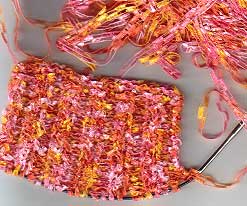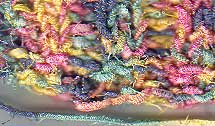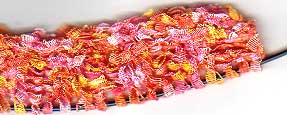Casting On
Normally I use two balls of yarn and the twisted German cast-on. But this ribbon yarn is slippery so I thought I would cast on in the easiest possible way by crocheting a chain and picking up stitches through the back of the chain.
I use plain white string for my crocheted chain and chain the number of stitches I need to cast-on PLUS ten stitches. The extra stitches allow me to skip any chains that might be malformed plus not have to use the beginning and ending chains. The knot is at the end of my chain where I cut the yarn and pulled it through the last loop. This is a reminder of which end is the one that will zip off when I am ready to remove it.
No matter what size yarn I am using, I use the same string for my chain - what varies is the size of the crochet hook. I use one a few sizes larger than the needles I am going to knit with so the first row will be loose (because I usually knit it twisted.)
Turing my chain over, I use my knitting needle to pick up one stitch through every purl bump on the back (skipping the first and last few bumps.)
We will be knitting in rounds on our circular needle and the instructions alway say to "Join, being careful not to twist the stitches." It can be difficult to see if your stitches are twisting around the needle especially in a furry or fancy yarn so I am going to work the first row FLAT. In other words, I am going to turn my work and work one row in pattern before I join the round.
Note: If you knit this row so the base of the stitches is twisted, you will be able to take off the crocheted chain immediately and the edge will have a looped finish. This is a light, loose edge suitable for scarves and shawls. If you knit the first row so the stitches are formed normally (not twisted), the loops will be "live." In other words, I could slooooowly unzip the string, placing each stitch on another circular needle and then knit them in the opposite direction. Try this for yourself on a little practice swatch - you can cast on ten stitches and do a little sample of each. HOW you knit the stitches to either twist them or not depends on how you picked them up through the chain - you will have to experiment to see what works for you.
The open or live edge is very handy if you want to work cuffs of a sweater or ribbing later. I did a Dale sweater where I cast on at the base of the yoke, did the fancy part and then worked the live stitches downward for the nice long boring part of the sweater. Conventional wisdom will tell you your pattern will be off one stitch on the pick-up-and-knit-in-the-other-direction part but it is not a big deal :-)
Back to our T-Top - once you have knit the first row in pattern (k2p2 ribbing)you will want to stop and count the stitches. Count them twice - it is critical have the correct number for your size at this point. I put a marker at the halfway point because I will need to find it later and I may as well get it marked now while I am counting anyway. Paperclips make good markers when you are counting because you can clip them on anywhere in the row.
TO JOIN the knitting into a circle - straighten the stitches on your needle so the cast-on edge is hanging down. My cast-on edge is easy for me to see because it is white against the orange yarn. The image on the left is what you DON'T want - a twist.
This a good place to double and triple check that your knitting is not twisting around the needle. If you have lots of stitches on a relatively short needle (I have 160 stitches on a 24 inch needle) it is easy to get twisted. If you are using a longer needle, you will find it much easier to see if the cast-on edge is circling the needle or not. If you start knitting and you DO have a twist,the only way to fix it is to rip back (unless you are making a cardigan in which case you could cut it open and untwist it because the place where you join your round is the center front of the cardigan.) But I know you don't want to cut today so check carefully.
To join - Instead of turning and knitting back, knit the first stitch on the left needle, going right across the gap. You will notice I left my starting tail nice and long - this is so I can sew the gap formed by working the first row flat - later. The tail also acts as my start-of-row marker. You can see the paperclip at the bottom of the right hand picture that marks my side seam.
WHEW! We have finally reached the fun part - knit in pattern until you reach the length specified for your size. This will be the bottom of the sleeve opening - you may want to measure something you already own to see if this is the length you really want. I am short waisted so I will probably make mine shorter than the pattern.
Next - Short Rows or How do I adjust for a larger bust/tummy/back?
It is a holiday and I have the day off so I am going to go knit now - see you later







